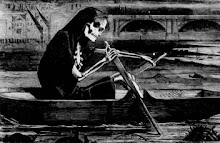Yes, "absent without blogging" is indeed the crime, and I plead "guilty as charged".
It's been a busy month, what with a fair bit of travel at the beginning and a quarter close at the end, both combining to take away whatever spare time there ever is in this life and making it seem like 30 days went by in 10.
Having said that, thanks to a friend in San Francisco we managed to see two operas in one June weekend, namely Tosca and Porgy & Bess. I've seen Tosca once before many years ago but didn't remember it that well going in to see this performance. Thankfully, it was a very strong production that was well sung and extremely well acted, so it was easy to reconnect very quickly with the tragic Tosca and the death-by-accidental-but-non-accidental-shooting of her lover, all set against a backdrop of Napoleon's successful Italian campaign of 1800. A very human and - for an Italian opera - very straightforward work that is truly timeless.
For me at least, Porgy and Bess was a complete unknown, other than of course having heard some of Gershwin's music extracted and turned into show tunes over the years. Leaving aside the controversy over what may or may not be no more than stereotypical presentations of African Americans, as a complete operatic body of work it's extremely well written and the performance on the night was absolutely top-notch. As required in the original writing, it featured an all-black cast that collectively delivered performances with real depth and sparkle, ably bringing to the fore the various individual roles that this opera features. Turns out that this is of particular importance here because it's as much an ensemble piece as it is a vehicle for the eponymous Porgy and Bess, something I certainly never realised beforehand.
Couple of interesting things struck me. Firstly, it's clear the drug trade had much better marketing in those days. Branding coke as "happy dust" beats anything the dealers have come up with subsequently. Who wouldn't want to try some happy dust versus, say, a pinch of smack, crack or horse? Secondly, for coastal folk they appear to have an unnatural fear of buzzards. The venerable albatross I could understand; seagulls, too, have their detractors; but buzzards? By the coast? Must be a southern thing.
Ah yes, the race question. It is hard to ignore, so let's not. From my standpoint, the simple answer is that after 75 years it's time to put that whole tortured and difficult debate to the rear, and focus instead on the role it plays as a work of art. And one of the purposes of art, surely, is to reflect the period in which it was produced, capturing a point in time through one of the (now increasing) array of media via which artistic vision can be successfully expressed. "It is what it is", in short; the product of a gifted white male who wanted to use an existing novel by DuBose Heyward as the basis for a folk opera.
What may look dated and stereotypical to us wasn't of course viewed the same way by observers in the mid 1930s, and indeed the work was often met with contemporary criticism regarding its portrayal of poor black workers. This prevailed over many years, and was apparently still evident in the 1970s.
As I saw mentioned elsewhere, it's a worthwhile exercise to perform a little thought experiment here: how differently would we view this work if it comprised the basic same libretto, directions and music, except with an all white setting? Would there have been the same outcry because of the negative view shown of poor white fishermen by such a production? Would we have decried the idea that poor whites can only resolve their problems through violence or temporarily escape their poverty through drink, drugs and gambling? Likely not, and so I prefer to think of this work in a color-blind way, enjoying it as theatre, as opera, as art, and not as a piece of social commentary.
As always, your mileage may vary!



No comments:
Post a Comment